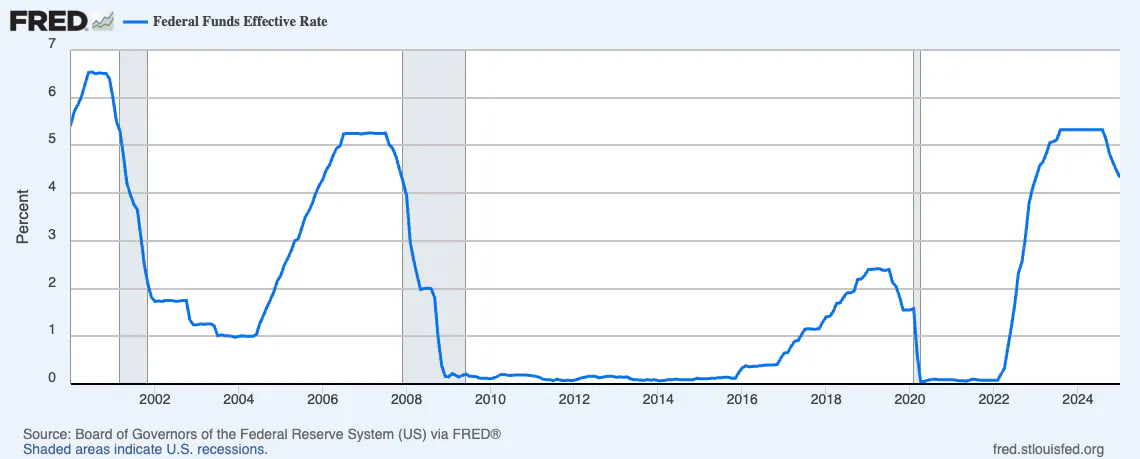
When interest rates fall, both Treasury bills (T-bills) and Money Market Funds (MMFs) are affected, but they respond in different ways due to their distinct characteristics. Understanding these differences can help treasurers make informed decisions about where to allocate their funds.
The Relationship Between Interest Rates and Short-Term Investments
The Federal Reserve’s role is to balance economic growth, inflation, and financial stability, which leads to fluctuations in interest rates over time. As the Federal Reserve adjusts rates in response to economic conditions—whether tightening to curb inflation or cutting rates to stimulate growth—short-term and fixed-income instruments react in distinct ways. T-bill rates, set at auction and determined by market demand, fall as investors seek safe, short-term returns, driving up the value of T-bills held by treasurers. Meanwhile, MMFs, which include short-term securities like repurchase agreements, T-bills, and commercial paper in a pooled fund, see their returns decrease more quickly as their underlying holdings roll over at lower rates. This dynamic played out during historical rate-cut cycles, such as the 2008 financial crisis and COVID-19 response, when the Fed slashed rates to near zero, reducing T-bill rates and Money Market Fund returns.

Fed Funds Rate from 2000 to 2025. Board of Governors of the Federal Reserve System (US), Federal Funds Effective Rate, retrieved from FRED, Federal Reserve Bank of St. Louis; https://fred.stlouisfed.org/series/FEDFUNDS, February 7, 2025.
For treasurers and institutional investors, understanding these shifts is critical to managing liquidity, optimizing returns, and balancing risk. In this article, we’ll explore how T-bills and MMFs respond to declining rates, how their risk and liquidity profiles compare, and what that means for corporate cash management strategies in changing interest rate environments.
What Happens to Treasury Bills When Interest Rates Fall?
Relative Risk and Duration
T-bills are considered one of the safest investments because they are backed by the full faith and credit of the U.S. government. The shorter the duration, the lower the interest rate risk, as T-bills with shorter maturities are less sensitive to changes in interest rates.
Stable Yield
One key feature of T-bills is that they guarantee a stable yield if held to maturity. When you purchase a T-bill, you know exactly what the return will be because they are sold at a discount and mature at face value. This provides predictability in returns, which is valuable in a low-interest-rate environment.
Behavior When Interest Rates Go Down
When interest rates fall, the yield on newly issued T-bills decreases. This means that new T-bills issued will offer lower interest rates compared to those issued before the rate cut. However, existing T-bills with higher interest rates become more attractive, causing their prices to rise in the secondary market. This price increase compensates for the lower yields on newly issued T-bills.
Treasurers holding T-bills to maturity are not affected by the fluctuations in the secondary market. They will receive the face value of the T-bill at maturity, thus locking in their yield at purchase regardless of changes in interest rates. This makes T-bills a stable investment option in terms of yield, especially for risk-averse treasurers.
Longer Duration T-Bills
Longer-duration T-bills (e.g., those with maturities of six months or more) are more sensitive to interest rate changes compared to shorter-duration T-bills. When interest rates go down, the price of longer-duration T-bills increases more significantly than that of shorter-duration T-bills.
For instance, a 6-month T-bill will have a more pronounced price increase compared to a 1-month T-bill when interest rates fall. This is due to the longer duration of the 6-month T-bill, which makes it more valuable in a declining interest rate environment. Conversely, when interest rates rise, the prices of longer-duration T-bills will decrease more significantly than shorter-duration T-bills.
What Happens to Money Market Funds (MMFs) When Interest Rates Fall?
Relative Risk and Duration
MMFs are investment vehicles that pool money from multiple investors to purchase short-term, high-quality debt securities, such as T-bills, repurchase agreements, commercial paper, and certificates of deposit. They aim to provide a stable value of $1 per share and pay dividends based on the interest earned from these securities. MMFs are subject to interest rate, counterparty, and credit risk, which should be evaluated before treasurers commit to a fund.
Stable Price
One of the main attractions of MMFs is their price stability. MMFs strive to maintain a stable Net Asset Value (NAV) of $1 per share. This means that the principal investment remains stable, making it a common option for treasurers seeking liquidity and capital preservation. However, the yield on MMFs is variable and can change with fluctuations in interest rates, and it is possible for the NAV to dip below $1, as seen in 2008 when the Reserve Primary Fund “broke the buck”
Behavior When Interest Rates Go Down
When interest rates fall, the yields on the securities held by MMFs decrease, leading to lower dividends. This can make MMFs less attractive compared to other investment options with higher yields, like T-bills in some cases. Additionally, while MMFs aim to maintain a stable NAV, there is a slight risk of NAV fluctuation as mentioned above.
The tradeoff for treasurers that liquidate from MMFs during periods of market volatility is that the yield on MMFs will decrease in a low-interest-rate environment, potentially resulting in lower overall returns.
Future Yields on MMFs
The future yields on MMFs are influenced by changes in short-term interest rates. When interest rates go down, the yields on newly issued securities purchased by MMFs will be lower, resulting in reduced dividends. Any funds that the MMF invested in overnight repurchase agreements will immediately start to receive lower yields.
Treasurers investing in MMFs need to be aware of the impact of interest rate changes on their returns. While MMFs provide stability and liquidity, their variable yields mean that returns can fluctuate based on market conditions, and yields aren’t “locked in” at the time of purchase. In a falling interest rate environment, treasurers may want to consider other investment options to achieve higher yields, while still maintaining a portion of their portfolio in MMFs or short-term T-bills for liquidity purposes.
Asset and Liability Duration Matching
Asset and liability duration matching is a crucial concept in managing investment portfolios, particularly when saving for specific future expenses. Duration matching involves aligning the maturity of investments (assets) with the timing of anticipated expenses (liabilities) to minimize interest rate risk and ensure that funds are available when needed.
For example, if a treasurer is planning for expenses a few months away, choosing an investment with a duration too low (e.g., an MMF or very short duration T-bill) can be risky because yields might go down further before the funds are needed. In this scenario, a longer duration T-bill (e.g., a 3- or 6-month T-bill) which matures roughly when the expenses are expected would be more appropriate to lock in a stable yield for the required period. This ensures that the investment will provide the necessary returns without being affected by short-term interest rate fluctuations.
Similarly, MMFs, while providing liquidity and capital preservation, may not be the best choice for matching asset and liability duration if the timing of the expense is known. MMFs have variable yields, and in a declining interest rate environment, the dividends paid will decrease. This variability can create uncertainty in the returns, making it challenging to match the exact timing of future expenses.
How Corporate Treasurers Can Navigate a Low-Rate Environment
Treasurers can use these insights when allocating cash to short-term investments. While rates are unpredictable, the possibility of a decline in rates makes a case for holding a certain percentage of cash in T-bills at all times.
Additionally, in a low-rate environment, as Money Market Fund returns decline, the fund’s expense ratio—if not adjusted—can take up a larger proportion of the overall yield, further impacting net returns.
Conclusion
Understanding how T-bills and MMFs respond to falling interest rates is essential for corporate treasurers looking to optimize their cash management strategies. While rates fluctuate over time and could shoot back up at any point, these two short-term cash vehicles react differently in a declining interest rate environment. T-bills provide fixed returns, therefore more value on secondary markets when rates begin to fall, while MMFs may adjust quickly to market conditions, making them more sensitive to rate drops.
Further reading

What is Even Safer Than a T-Bill Today? A T-Bill Tomorrow
Treasury Bills and the Debt Ceiling: A Look at Safety and Stability The US national debt is once again approaching the debt ceiling, reaching a point that forced Treasury Secretary Janet Yellen to take action and begin using extraordinary measures on January 21st. Read more →

The Golden Rule for Corporate Cash Allocation
In today’s fast-paced, often volatile financial landscape, corporate treasurers face the critical task of managing cash reserves efficiently. Read more →

How T-Bills Fit Into Corporate Treasury
Especially in today’s elevated rate environment, corporate treasurers are largely seeking its benefits while still maintaining liquidity and protecting principal. Read more →